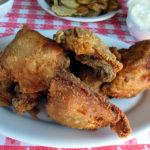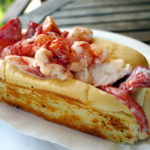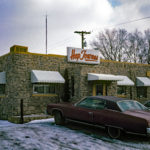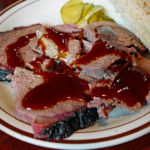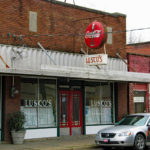St. Louis
America's distinctive regional dishes are often associated with cities: the creamy grits of Charleston, the pig sandwich of Memphis, Buffalo wings, Cincinnati five-way chili, San Diego fish tacos, Chicago pan pizza. Visiting these cities can be a tasty way to discover variations of the special-ties and to investigate how cooks in different neighborhoods and different sorts of restaurants interpret them.

By Jane and Michael Stern
Originally Published 1999 Gourmet Magazine
America’s distinctive regional dishes are often associated with cities: the creamy grits of Charleston, the pig sandwich of Memphis, Buffalo wings, Cincinnati five-way chili, San Diego fish tacos, Chicago pan pizza. Visiting these cities can be a tasty way to discover variations of the special-ties and to investigate how cooks in different neighborhoods and different sorts of restaurants interpret them.
That is what we intended to do when we came to St. Louis with toasted ravioli in our sights. Toasted ravioli appears on menus throughout the Gateway City, from the spaghetti houses of The Hill (the old Italian neighborhood) to Busch’s Grove out on Clayton Road in Ladue (the old old-money neighborhood). The pasta is filled with a spiced-beef hash and, instead of being boiled, is breaded and fried crisp, and served as an hors d’oeuvre with a tomato sauce for dipping.
We were waylaid in our research, however, by two realizations. First, almost every restaurant in town that serves toasted ravioli either buys it from the same pasta maker or manages to make its own taste exactly like everybody else’s. Variations are subtle indeed, more a matter of what the tomato dipping sauce is like than the ravioli itself. Second, toasted ravioli is merely the best-known of a multitude of unusual local specialties. To establish an authentic portrait of St. Louis’s culinary character, the inquisitive food pilgrim needs to cut a wider swath. St. Louisans have an extraordinary number of peculiar edible enthusiasms, reflecting a River City personality that is mostly Midwestern but with a shot of the South and the spice of ethnic heritages that still defines its neighborhoods. Some of these specialties are so obscure that they are unknown even to a great many food-savvy locals.
Unique St. Louis dishes range from Americanized versions of old-world fare, such as the Italianate toasted ravioli and “spiedini” (which is how neighborhood menus list breaded and charcoal-cooked veal, beef, or chicken), to a mysterious German-bakery specialty known as gooey butter cake. Our scope broadened, we embarked on an exploration of the kaleidoscope of flavors that make St. Louis such a compelling eater’s destination.
GIOVANNI’S menu doesn’t even mention toasted ravioli, but of course the kitchen will prepare it for you. It’s that sort of place: Your comfort is paramount, from the moment the valet mindfully escorts you from car to front door. Inside, a host says with unassailable credibility that it is his pleasure to have you at the restaurant this evening. Waiters in impeccable tuxedos fairly swarm the table, pouring water and wine, removing crumbs, arranging silverware, ensuring perfection every way they can. Meals are heated and assembled in dining-room chafing dishes; of particular note are the bowtie noodles in smoked-salmon cream sauce and tooth-some rigatoni in lobster-vodka sauce. Toasted ravioli, a rugged sort of pasta, is an oddity in this svelte setting, but it is exemplary. Crisp and chewy, with a Parmesan zest to the crust and accompanied by a smoky bolognese sauce for dipping, it is brought to table by the captain, who says in all apparent sincerity, “From the bottom of my heart, enjoy!”
For toasted ravioli in another singular milieu, we recommend a trip to the west-side suburb of Ladue and a restaurant called BUSCH’s GROVE. St. Louis’s elite have favored this countryside oasis since the nineteenth century, when it began as a beer garden. It still feels like a rich-man’s picnic if you dine in one of the dreamy gazebos out back, where summer breezes make the nuclear-strength mint juleps all the more refreshing. But indoor dining is a privilege, too—cool and dark like some sort of permanent vacation from the cares of the world. Waiters work the tables with deferential antebellum style, and the meals they serve show scant evidence of any culinary innovation more recent than Calvin Coolidge’s administration. For dinner, you want beef. Before tucking into that tasty char broil strip steak or slow-roasted prime rib, we suggest a charmingly unfashionable Russ’s salad, which is a finely chopped jumble of iceberg lettuce, ham, turkey, shrimp, crab meat, and American cheese with Roquefort, Thousand Island, and Italian dressings. And, of course, there’s toasted ravioli: nicely crusty with Parmesan cheese and herbs, arrayed around a bowl of marinara sauce.
If after dining with the swells at Busch’ s Grove you need a walk on the wild side of St. Louis gastronomy, have a morning slinger at O.T. HODGE CHILE PARLOR on the South Side, preferably at 5:30, after being up all night. The slinger is an amazing meal of two modest-sized cheeseburger patties sided by griddle-cooked fried potatoes, topped with an egg and completely blanketed with chili, then garnished with grated cheese and chopped raw onions. The only other place in town that serves anything remotely like it is the Goody Goody Diner, where a dish called Wilbur is a three-egg omelet with diced ham, bell peppers, onions, cheese, and hash browns covered in chili and more cheese. O.T. Hodge chili itself is a no bean diner classic—thick, meaty, not ferociously spiced—available also on platters of “chile mac” (atop spaghetti noodles) and “chile mac a la mode” (atop spaghetti noodles and eggs). This O.T. Hodge (one of a small local chain that dates back to 1904) is a proverbial urban hash house with a spanking-clean tiny-tile floor, a staff of pugnacious waitresses, and a menu that is a lexicon of diner lingo, including “balloon juice” (seltzer), “sweep the kitchen” (hash), and “put out the lights and cry” (liver and onions). Every morning the proprietor sets out a tray of his home-made Rice Krispies squares for dessert.
The oddest of all St. Louis specialties—one so reprobate that no St. Louis food authority or cultural historian owns up to knowing anything about it—is the St. Paul sandwich. Yet here it is, on the menu of virtually every take-out chop suey parlor in town. How it got named St. Paul, and why it became a low-end Chinese restaurant standard, we cannot say, but this is what it is: a thick patty of egg foo yong that is cooked to your specifications with diced pork, ham, chicken, beef, shrimp, or just vegetables; placed between two pieces of white bread; and dressed with lettuce, tomato, and mayo. At CHINESE EXPRESS, a fine example of the type of casual restaurant that serves St. Pawls—and an ethnic enclave where English is only barely a second language—the sandwiches range in price from $1.35 for plain to $2.19 for the works. (With just a slice of cheese it’s $1.51.)
On the subject of edible oddities, we need to mention brains, which are fried crisp and served in sandwiches at several local taverns, the best of which, such as DIECKMEYER’S, make a point of serving them halved, rather than ground up into the far less appealing patties of lesser establishments.
C&K BARBECUE RESTAURANT No. 3 has a strange St. Louis preference on its menu, too: snouts, or, as all local connoisseurs pronounce it, “snoots,” which are crusty chunks of baked pig proboscis bathed in sweet barbecue sauce. They are excruciatingly rich and piggy—definitely an acquired taste—but C&K, a take-out stand, is also a most rewarding stop for more accessible smokehouse soul food, including rib racks, rib tips, whole chickens, and pork links. The rib tips in particular are melting-tender and easy to eat, sweet and smoky, accompanied by a most unusual creamy potato salad that is also sweet. C&K’s thick red sauce (available hot or mild to take home) is a St. Louis treasure.
If brains and “snoots” in taverns and barbecue shacks are not your idea of eating fun, may we suggest a piece of gooey butter cake from a neighborhood bakery? “It’s the perfect Tupperware Party food,” according to St. Louis Post-Dispatch food editor Judith Evans, our gooey butter cake tipster. It was supposedly created in the 1930s when a now-forgotten baker mixed the wrong ingredients for a cake but decided to bake it anyway. The result—a low-rise pastry with a tender crust around the edge and a moist center that is custard-soft—has become a St. Louis passion and a hallmark of the city’s best bakeries. Supersweet and luscious, gooey butter cake just may be the best thing on earth to have with morning coffee.
Gertrude Kromat, who has been at the LAKE FOREST PASTRY SHOP since shortly after World War II, recalls when St. Louis neighborhoods were filled with good bakeries—more than five hundred citywide by some counts. Lake Forest is a grand survivor, a civilized take-a-number store that feels like a specialist’s waiting room—hushed, reverent, filled with customers’ anticipation. A staff of uniformed ladies with buttercream complexions speak in soothing tones and glide among the cases and shelves, boxing bundt cakes, cupcakes, tea cakes, and coffeecakes; round cakes and square cakes; cakes that are strawberry-iced, chocolate-sprinkled, nut-studded, sugar-dusted, coconut-scattered, and caramel-glazed. There are several dozen ravishing cake varieties every day (not to mention cobblestone Cheddar bread, crusty ryes, frozen Vienna tortes, and baked Alaskas); among them, of course, is gooey butter cake—less deliriously sweet than the other versions we sampled, and somewhat tidier because the cake and its topping remain two distinct elements. Pieces cut from the center are drippingly moist; outside segments balance gooey sweetness with basic coffee cake.
The subject of sweet St. Louis cannot be closed without a visit to TED DREWES, where frozen custard is king. Drewes’s custard is fresh and pure; vanilla is the only variety that comes out of the machines. Anything else—from basic chocolate and strawberry to the dozens of different flavoring agents, including fudge, cherries, cookies, nuts, and candy bars—is mixed in to order. The house specialty, and a St. Louis passion since Ted Drewes opened his first store here in 1930, is known as a concrete—a milk-shake made so thick that each cupful is handed out the order window upside down, with a spoon and straw firmly planted in the luxurious custard.
Pretzels are not unique to St. Louis, but we’d match those made at GIEGERICH every morning against any city’s best soft pretzels. There are three varieties: little rye sticks the shape of dinner rolls, about two inches long and studded with caraway seeds; traditional twists crusted with coarse-grained salt; and foot-long sticks, also salted. When we walked in the store about 9:30 A.M. we had to wake up the baker, who was snoozing behind the counter among shelves of his just-made delicacies. As he bagged some of each for us he explained that a quick pre-oven dip in sodium hydroxide is what gives these superb pretzels their tawny crust, within which is a cakey interior that is pure joy to chew. Be sure to get there early; by midmorning the selection may be limited or all the pretzels may be sold.
Giegerich has been around since 1852; the newcomer among pretzel shops is Gus’, established 1920, where the pretzels are softer, not as chewy, and slicker-crusted. They are available as twists and sticks, numbers and letters, and—best of all—as the casing for three different kinds of ready-to-eat hot pigs-in-a-blanket. (However, there is no place to eat here; business is strictly take-out.) These hefty tubular “pretzel sandwiches” are easy to dip, bite by bite, in little cups of mustard or melted Cheddar cheese, both of which are available at the counter, and the varieties of sausage inside the pretzel include a typically St. Louis choice of Italian salsiccia, German bratwurst, and all-American hot dog.
Busch’s Grove (permanently closed)
9160 Clayton Road
St. Louis, MO
NO. 3 4390 Jennings Station Road
Chinese Express (permanently closed)
1230 Hampton Avenue
St. Louis, MO
Dieckmeyer’s (permanently closed)
6201 South Broadway
St. Louis, MO
Giegerich (permanently closed)
2826 South Jefferson Avenue
St. Louis, MO
Giovanni’s (permanently closed)
5201 Shaw Avenue
St. Louis, MO
Gus’ Pretzel Shop
Lake Forest Pastry Shop (permanently closed)
7737 Clayton Road
St. Louis, MO
O.T. Hodge Chile Parlor (permanently closed)
1622 South Jefferson Avenue
St. Louis, MO
Discuss
What do you think of St. Louis?
Related Articles
Stroud’s
By Jane and Michael Stern Originally Published 1995 Gourmet Magazine Chicken...
The Lobster Roll Honor Roll
Maine is the only state in America that features a picture of cooked food on its license...
Meat-And-Three
A few years back, country singer Ray Stevens invited a New York friend to join him at one of...
Top 12 favorite Ice Cream Scoops
WITH THE EXCEPTION of the hot dog bun, there has never been an edible invention as...
Top 5 BBQ Restaurants | Western Kentucky
Get yourself to Western Kentucky for great BBQ I see the food shows on TV where...
Best restaurants in Greenwood, MS | Hot Licks Delta Style
Ever since we first ate margarine-sauced pompano at Lusco’s, in Greenwood,...

